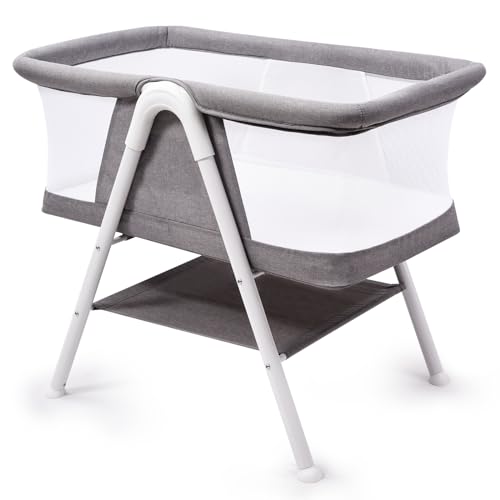Bedside Cosleeper
A bedside cosleeper is attached to your adult bed. It's safe, as long as you adhere to the CSPC safety guidelines for infant sleep spaces.
These guidelines are similar to the crib bedding standards. Read more about the guidelines here. The most important features to take into consideration when selecting a bedside sleeper are: Safety Comfort, Convenience, and Safety.

Safety
In accordance with the American Academy of Pediatrics' recommendation that infants are in the same room with their parents cosleeping (a practice that is also known as bed-sharing) has gained popularity with many new and expecting parents. The Academy recommends that room-sharing with a baby is safer than sleeping in the same bed as parents, as it reduces the risk of Sudden Unexpected Infant Death (SIDS). The AAP does not advocate bed-sharing but it does recommend that co-sleeping on separate sleeping surfaces is a good option to decrease the risk of SIDS. The creation of the bedside crib was important for a number of families.
A bedside cosleeper is attached to a bed frame that is suitable for adults. It's a crib like sleeper. The bedside cosleeper lets parents to easily monitor their child and allows them the freedom of sleeping in a bed while keeping their child close by. The best cosleepers have strict safety standards and are made using durable, high-quality materials. To ensure your child's safety ensure that you look for the Juvenile Products Manufacturers Association stamp of approval. 4-in-1 bedside crib is a sign of rigorous testing and quality control.
The safety of a crib is dependent on several factors. This includes the way it's put in place and secured onto the parent's mattress. If the bedside cosleeper isn't connected to the bed of the parent in a way that blocks the gaps and openings where an infant can become trapped, it could pose the risk of suffocation. It is vital that the attachment system of the bedside sleeper be tested to ensure that it can withstand forces that are imposed to it during use, like the parent rolling on and off the sleeper. The attachment system or the corners of the bedside sleeper should be exposed to the horizontal force.
The standard that is voluntary for bedside sleepers includes by reference the federal consumer product safety standard for bassinets and cradles (16 CFR part 1218) and includes requirements for the performance of enclosed openings with a fabric-side. The requirements that are mandatory in the standard also address head and neck entrapment hazards by insisting that following the application and release of a 50-lb. The standard also states that following the release and application of a 50-lb. It is not allowed to create a gap that is greater than 1.0 in. ASTM's electronic Reading Room offers read-only versions of the standard.
bedside co sleeper have resisted cosleeping because of fears of suffocation, SIDS or the "Ferberization" process that forces children to be in a room by themselves, anthropologists have long noted that the majority of mammals and primates as well as those living in non-Western societies, frequently coslept. This could be due to the fact that infants are calmed by the familiar voice of their mother and it may also help them learn to self-soothe.
The top bedside sleepers have an innovative design that is attached to the side of a mattress and swivels so you can easily access it for diaper changes or feedings during the middle of the night. Look for a model with adjustable feet, which retract to accommodate various mattress sizes. It should also have an ample storage area to store all of your baby's essentials.
Choose a bedside crib that fits the standard crib bedding, so that it's safe to use as your child grows. You may also want to consider an adjustable model that can transform into a play yard or deeper bassinet for a long time of use, and folds easily for travel.
Portability
A bedside cosleeper that has wheels or a lightweight base is easier to move than one that has a heavy wooden frame or a substantial base. The babybay bedside sleeper, HALO bassiNest essencetia, and Snoo Smart Sleeper are all movable. They come with adjustable feet that retract to accommodate platforms; legs that fold inward to provide maximum access to the mattress; and 100 mesh sidewalls that allow airflow without covering baby's mouth or nose.
bedside crib or cot is a great option. It adjusts in 1" increments and can be used as a bassinet or portable bed. It also swivels to allow for easy access to your baby to help her relax, nurse her, or monitor them during the night.
